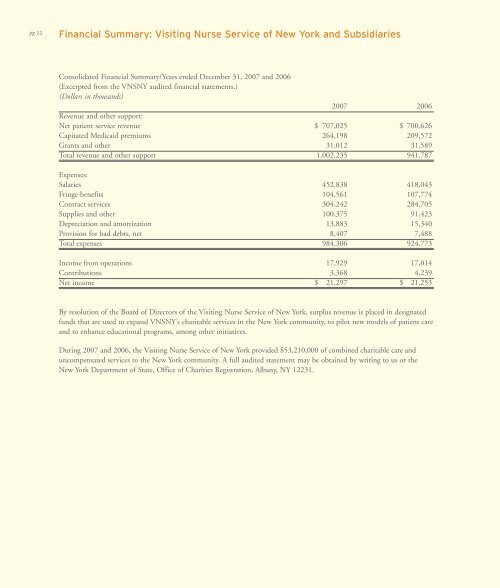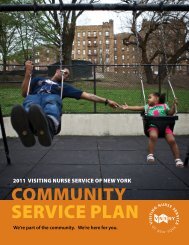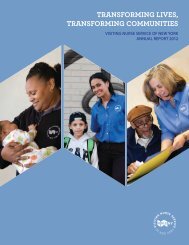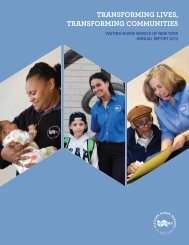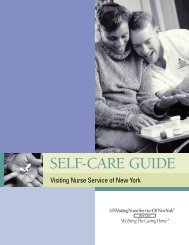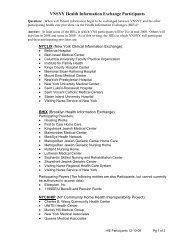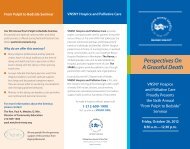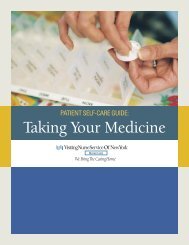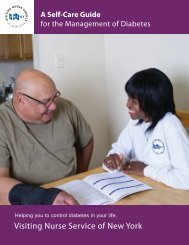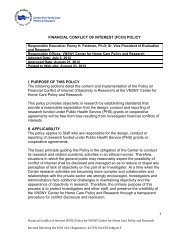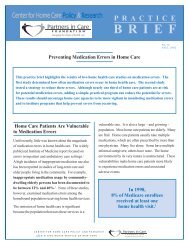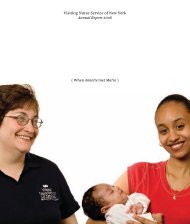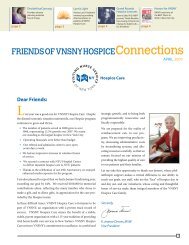2007 Annual Report: We're Here. - Visiting Nurse Service of New York
2007 Annual Report: We're Here. - Visiting Nurse Service of New York
2007 Annual Report: We're Here. - Visiting Nurse Service of New York
Create successful ePaper yourself
Turn your PDF publications into a flip-book with our unique Google optimized e-Paper software.
pg 22Financial Summary: <strong>Visiting</strong> <strong>Nurse</strong> <strong>Service</strong> <strong>of</strong> <strong>New</strong> <strong>York</strong> and SubsidiariesCenter for Home Care Policy & Researchpg 23Consolidated Financial Summary/Years ended December 31, <strong>2007</strong> and 2006(Excerpted from the VNSNY audited financial statements.)(Dollars in thousands)<strong>2007</strong> 2006Revenue and other support:Net patient service revenue $ 707,025 $ 700,626Capitated Medicaid premiums 264,198 209,572Grants and other 31,012 31,589Total revenue and other support 1,002,235 941,787Expenses:Salaries 452,838 418,043Fringe benefits 104,561 107,774Contract services 304,242 284,705Supplies and other 100,375 91,423Depreciation and amortization 13,883 15,340Provision for bad debts, net 8,407 7,488Total expenses 984,306 924,773Income from operations 17,929 17,014Contributions 3,368 4,239Net income $ 21,297 $ 21,253By resolution <strong>of</strong> the Board <strong>of</strong> Directors <strong>of</strong> the <strong>Visiting</strong> <strong>Nurse</strong> <strong>Service</strong> <strong>of</strong> <strong>New</strong> <strong>York</strong>, surplus revenue is placed in designatedfunds that are used to expand VNSNY’s charitable services in the <strong>New</strong> <strong>York</strong> community, to pilot new models <strong>of</strong> patient careand to enhance educational programs, among other initiatives.During <strong>2007</strong> and 2006, the <strong>Visiting</strong> <strong>Nurse</strong> <strong>Service</strong> <strong>of</strong> <strong>New</strong> <strong>York</strong> provided $53,210,000 <strong>of</strong> combined charitable care anduncompensated services to the <strong>New</strong> <strong>York</strong> community. A full audited statement may be obtained by writing to us or the<strong>New</strong> <strong>York</strong> Department <strong>of</strong> State, Office <strong>of</strong> Charities Registration, Albany, NY 12231.Promoting Healing through Falls PreventionAmong Older AdultsFalls are the leading cause <strong>of</strong> death from injury for adultsage 65 and older, and people in this age group have as muchas a one-in-three chance <strong>of</strong> falling. In collaboration withVNSNY Rehabilitation <strong>Service</strong>s, the Research Center hascompleted a project to identify those at greatest risk <strong>of</strong> falls.The study <strong>of</strong> 69 home care patients found that the simple“Timed Up & Go” (TUG) test, administered at a patient’sfirst physical therapy visit, is a significant predictor <strong>of</strong> thelikelihood <strong>of</strong> a fall.During the test, the therapist asks the patient to stand upfrom a chair, walk 10 feet, turn around, walk back, and sitdown again. If it takes the patient more than 30 seconds,he or she is at higher risk <strong>of</strong> falls. An especially notablefinding <strong>of</strong> the study was that a score <strong>of</strong> 30 to 39 seconds—not necessarily the highest score—was the most predictive<strong>of</strong> falls risk.“A standard VNSNY physical therapy falls-preventionintervention is already provided to patients identified as atrisk <strong>of</strong> falls,” says Chris Murtaugh, Ph.D., associate director<strong>of</strong> the Research Center. “This study will really help us focusin on those patients who are most at risk, and it contributesan important piece to the literature by showing the range <strong>of</strong>TUG scores associated with the highest risk <strong>of</strong> a fall afteradmission to home health care.”“This evidence-based test is an important part <strong>of</strong> ourrepertoire,” adds Eileen Bach, M.Ed., P.T., director <strong>of</strong>Rehabilitation Quality Assurance and Education. “Physicaltherapists routinely teach patients about balance and safety.Now, knowing more accurately which patients are at risk<strong>of</strong> falls will help therapists pay particular attention to theenvironmental issues in these patients’ homes, for example,making sure that they have the right assistive device andintroducing key exercises to promote balance.”Funded by The Jacob and Valeria Langeloth Foundation, thisstudy is part <strong>of</strong> a larger research project testing an interventionthat includes education <strong>of</strong> the family caregiver.Establishing a National Framework for GeriatricHome Care ExcellencePeople who receive home care today are older and morelikely to have multiple diseases. However, there are no wellestablishedguidelines for caring for more complex home carepatients and addressing the health conditions, risks, and goalsthat change with advanced age. Home health agencies do nothave a comprehensive source <strong>of</strong> information on best practicesthat are relevant for frail older adults.Beginning in May <strong>2007</strong>, with a sixteen-month grant fromThe John A. Hartford Foundation, the Research Centerlaunched the National Framework for Geriatric Home CareExcellence project to assess how existing geriatric knowledgecan be adapted to the home care setting and to determinewhich key areas need further research and development.“In the past, a typical home care patient was someonerecovering from a surgery or a single illness,” says AnnetteTotten, Ph.D., project director. “Now, that person mighthave diabetes and dementia as well.” While much informationon geriatric care exists, little <strong>of</strong> it has been implemented inhome care on a national scale.“Ultimately with this project, VNSNY istaking the lead in ensuring that the homecare industry <strong>of</strong>fers care that is tailored tothe specific needs <strong>of</strong> older people, allowingthem to age in their communities,”says Dr. Totten.The National Framework established an advisory council<strong>of</strong> 16 national experts in related fields, commissioned backgroundpapers, began reviewing clinical literature, andassembled regional practice focus groups to discuss specificissues in home health related to geriatrics. A consensusstatement will be drawn up at a national conference this Julyand a report will be released later this summer.


